
Europe and Mediterranean: Paris & Normandy Cruise
Uniworld Boutique River Cruises
A journey steeped in wonder. Cruise from Paris through Normandy’s countryside, uncovering its many charms: Richard the Lionheart’s Chateau Gaillard, the medieval capital of Rouen, Monet’s beloved home in Giverny and the famed Normandy beaches. Experience a different side of Northern France’s history with a choice to tour two majestic palaces, Versailles, once home to Louis XVI and Marie Antoinette, or Château de Malmaison, once home to Napoleon’s first empress, Josephine.

True All-Inclusive Boutique River Cruising™
All gratuities for onboard services
Unlimited fine wine, beer, spirits and nonalcoholic beverages**
Shore excursions with local experts as your guide
Internet and Wi-Fi
All arrival and departure day transfers
Executive Member Benefit
Executive Members receive an annual 2% Reward, up to $1,250, on qualified Costco Travel purchases
Receive a $50 shipboard credit per person (maximum $100 per stateroom)♦♦
Digital Costco Shop Card
Member Exclusive: Digital Costco Shop Card with every Uniworld river cruise†
Sailing Itinerary

Note: Cruise itineraries are subject to change. Please verify ports and times directly with the cruise line.
Overview
Regarded as the most romantic city in the world, Paris is a wonderful place for couples to visit. It is also full of famous landmarks and museums, however, so even if you are going with some friends or on your own, you won't find it hard to fill your days. Paris was founded over 2000 years ago whenthe Gauls of the Parisii tribe set down there between 250 and 200 BC, making the French capital more than 2000 years old. They settled on an island in the River Seine that today is known as Ile de la Cité. It is from here that the city center developed. Lutetia (Lutece), as Paris was known in ancient times, was conquered by Julius Caesar in 52 BC making it a Roman center in the Middle Ages. It wasn’t until Hugh Capet, the Count of Paris, was crowned King of France that the city’s position as France’s capital became established. Under the leadership of Etienne Marcel between 1355 and 1358, Paris finally declared itself an independent commune. Then again in 1528, Paris was named the capital of the French monarchy under Francais I. It was he who reconstructed the fortress of the Louvre and also decided to build a city hall in Paris, as it was the capital. With a city steeped in so much history, it isn’t surprising that there is so much to see and do in this city. Paris’, and arguably France’, best-known landmark towers over the city, while the Champs Elysées is one of Europe’s most impressive boulevards. Above all Paris will never get rid of the stereotype that is the city of lovers. Indeed, many happy couples get engaged on the Eiffel Tower, and hundreds of others are joined at the hip for their weekends away, but it doesn’t take anything away from the time the budget traveler can have over the space of a few days in the French capital.
Overview
Vernon is a very ancient town attested by prehistorical, Celtic, Gallo-Roman, and Merovingian remains. It became like Gisors an important military town after the foundation of the Duchy of Normandy. Richard de Reviers, Captain of Vernon, took part in the battle of Hastings in 1066 and settled down in England. Vernon played a political and military part during the long rivalry between the Capetians and Plantagenets. It was attached to the French kingdom by Philippe Auguste in 1196, even before the rest of Normandy (1204). Philippe Auguste had the castle of Vernon built, and the Keep and a tower remain.Saint-Louis often came to Vernon where he used to meet his friend Eudes Rigaud, archbishop of Rouen. He founded the Hotel-Dieu (the present Saint-Louis Hospital) and endowed it richly, as precious charters testify.In the 18th century, Vernon, like Gisors, Les Andelys, and Lyons-la-Forêt was transferred by Louis XV to the Count of Belle-Isle in exchange for the island of Belle-Isle-en-Mer. After his death, his properties passed back to the crown, then they were granted to the Duke of Bourbon-Penthièvre, grandson of Louis XIV and Madame de Montespan, and andgrandfatherr of Louis-Philippe.Vernon keeps the memory of the heroic battles fought in 1870 by the mobile troops of Ardeche.The town was partially destroyed in 1940 but it rose from its ruins. It is presently the second town in the department.
Overview
Rouen is a must for anyone who loves the arts, fine foods, and long strolls through cobblestone streets. From the most classical to the most innovative, the city offers a wide array of cultural activities. Rouen's museums, theatres, art galleries,s and other attractions are amongst the richest and most dynamic in France outside of Paris. Its richly endowed museums include the Musee des Beaux-Arts (or Fine Arts Museum), where visitors can appreciate one of the finest art collections in France, with world-class masterpieces by Velasquez, Gericault, Monet, and others. The Theatre of the Arts/Normandy Opera House presents a vast program of lyrical music, as well as other forms from classical to rock and roll. Each year, more than 400 concerts are music to the ears of Rouen.Cultural activities and other festivities make their way onto the streets of Rouen during several popular events attended by thousands and even hundreds of thousands of people. Theatre, painting, dance, music, cinema, and architecture: the muses still grace the birthplace of Corneille and Flaubert.
Overview
CAUX, a town in France, in the department of Seine-Inferieure. It is situated on the right bank of the Seine, the tidal wave of which (mascara) can be well seen at this point. The chief interest of the town lies in its church, a building of the 15th and the early 16th centuries. Round its top run balustrades formed of Gothic letters, which read as part of the Magnificent. Its west portal, the decoration of the spire of the tower. The town also possesses’ several old houses. Its industries include tanning and leather carrying and there is the grain trade The port has a small trade in coal, livestock, and farm produce.
Overview
Rouen is a must for anyone who loves the arts, fine foods, and long strolls through cobblestone streets. From the most classical to the most innovative, the city offers a wide array of cultural activities. Rouen's museums, theatres, art galleries,s and other attractions are amongst the richest and most dynamic in France outside of Paris. Its richly endowed museums include the Musee des Beaux-Arts (or Fine Arts Museum), where visitors can appreciate one of the finest art collections in France, with world-class masterpieces by Velasquez, Gericault, Monet, and others. The Theatre of the Arts/Normandy Opera House presents a vast program of lyrical music, as well as other forms from classical to rock and roll. Each year, more than 400 concerts are music to the ears of Rouen.Cultural activities and other festivities make their way onto the streets of Rouen during several popular events attended by thousands and even hundreds of thousands of people. Theatre, painting, dance, music, cinema, and architecture: the muses still grace the birthplace of Corneille and Flaubert.
Overview
Versailles is a commune in the department of the Yvelines, Île-de-France, known worldwide for the Château de Versailles and the gardens of Versailles, designated UNESCO World Heritage Sites.
Overview
Regarded as the most romantic city in the world, Paris is a wonderful place for couples to visit. It is also full of famous landmarks and museums, however, so even if you are going with some friends or on your own, you won't find it hard to fill your days. Paris was founded over 2000 years ago whenthe Gauls of the Parisii tribe set down there between 250 and 200 BC, making the French capital more than 2000 years old. They settled on an island in the River Seine that today is known as Ile de la Cité. It is from here that the city center developed. Lutetia (Lutece), as Paris was known in ancient times, was conquered by Julius Caesar in 52 BC making it a Roman center in the Middle Ages. It wasn’t until Hugh Capet, the Count of Paris, was crowned King of France that the city’s position as France’s capital became established. Under the leadership of Etienne Marcel between 1355 and 1358, Paris finally declared itself an independent commune. Then again in 1528, Paris was named the capital of the French monarchy under Francais I. It was he who reconstructed the fortress of the Louvre and also decided to build a city hall in Paris, as it was the capital. With a city steeped in so much history, it isn’t surprising that there is so much to see and do in this city. Paris’, and arguably France’, best-known landmark towers over the city, while the Champs Elysées is one of Europe’s most impressive boulevards. Above all Paris will never get rid of the stereotype that is the city of lovers. Indeed, many happy couples get engaged on the Eiffel Tower, and hundreds of others are joined at the hip for their weekends away, but it doesn’t take anything away from the time the budget traveler can have over the space of a few days in the French capital.
Overview
Regarded as the most romantic city in the world, Paris is a wonderful place for couples to visit. It is also full of famous landmarks and museums, however, so even if you are going with some friends or on your own, you won't find it hard to fill your days. Paris was founded over 2000 years ago whenthe Gauls of the Parisii tribe set down there between 250 and 200 BC, making the French capital more than 2000 years old. They settled on an island in the River Seine that today is known as Ile de la Cité. It is from here that the city center developed. Lutetia (Lutece), as Paris was known in ancient times, was conquered by Julius Caesar in 52 BC making it a Roman center in the Middle Ages. It wasn’t until Hugh Capet, the Count of Paris, was crowned King of France that the city’s position as France’s capital became established. Under the leadership of Etienne Marcel between 1355 and 1358, Paris finally declared itself an independent commune. Then again in 1528, Paris was named the capital of the French monarchy under Francais I. It was he who reconstructed the fortress of the Louvre and also decided to build a city hall in Paris, as it was the capital. With a city steeped in so much history, it isn’t surprising that there is so much to see and do in this city. Paris’, and arguably France’, best-known landmark towers over the city, while the Champs Elysées is one of Europe’s most impressive boulevards. Above all Paris will never get rid of the stereotype that is the city of lovers. Indeed, many happy couples get engaged on the Eiffel Tower, and hundreds of others are joined at the hip for their weekends away, but it doesn’t take anything away from the time the budget traveler can have over the space of a few days in the French capital.
Onboard the S.S. Joie de Vivre
S.S. Joie de Vivre
Year Built: 2016
Double Occupancy Capacity: 108
Uniworld’s newest Super Ship—S.S. Joie de Vivre—is designed to reflect the “joy of living” as it cruises the Seine River in northern France. This luxurious 128-passenger vessel is a showcase for handcrafted furniture, sumptuous fabrics, beautiful antiques, gilded accents and every modern convenience. The Salon de Toulouse features a full-service bar and curated antiques from renowned auction houses. Enticing dining venues include Le Restaurant Pigalle, Bistro Saint-Germain and Café Flore. Intimately scaled so it can dock in the heart of Paris, the Joie de Vivre features two Royal Suites, eight Junior Suites, and 54 staterooms, all with made-to-order Savoir® of England beds and marble-lined bathrooms.
Activities & Services (included in cruise)
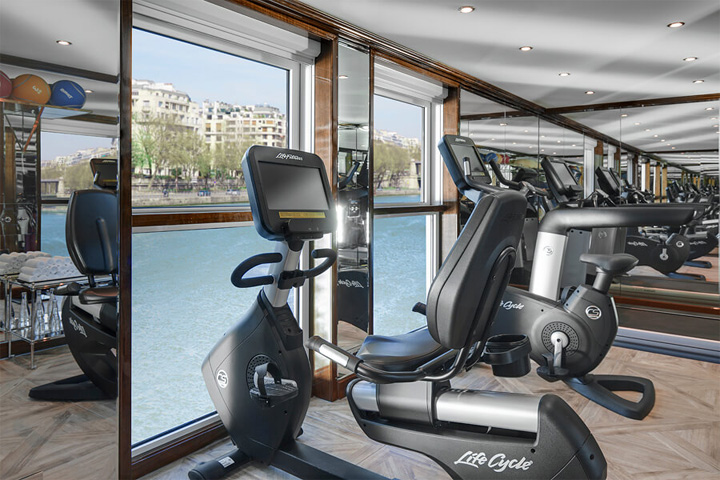
Fitness Center
- Fitness Center
- Guest Lecturers
- Pool - Indoor/Covered
- Bars/Lounges
- Concierge Desk
- Elevators
- Safe Deposit Boxes
- Self-Service Laundromat
Activities & Services (available for an extra fee)
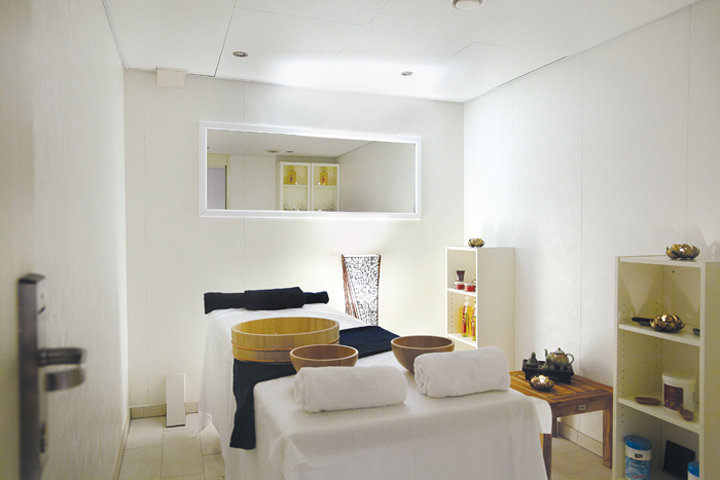
Spa
- Spa Services/Massage
- Dry Cleaning/ Laundry Service
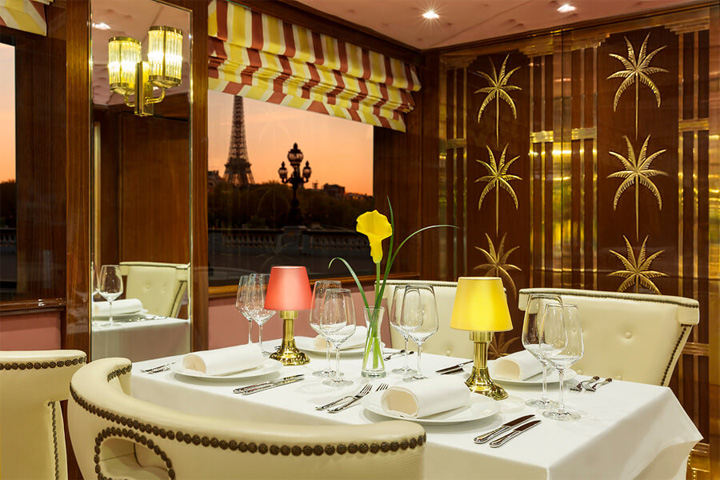
Main Dining Room
Main Dining
Main Restaurant (open seating): This seating option allows you to choose when and with whom you dine. Menus are a blend of classic cuisine with a touch of contemporary elegance, and are created using only the finest and freshest ingredients often brought onboard from local ports of call. You'll be surrounded by the beauty of passing riverbank towns and villages.
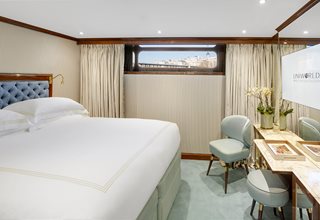
Category: CL
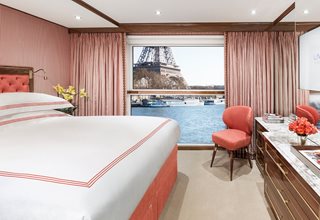
Category: FB
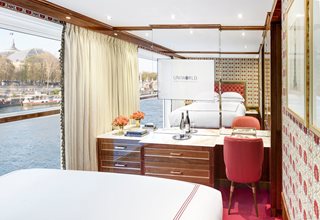
Category: DF
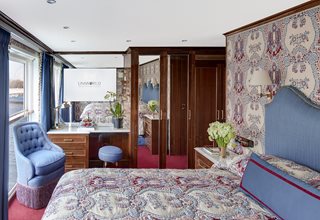
Category: S
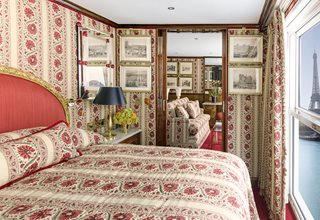
Category: GS

| Symbol | Description |
|---|---|
 | Elevator |
 | Triple accommodation available |
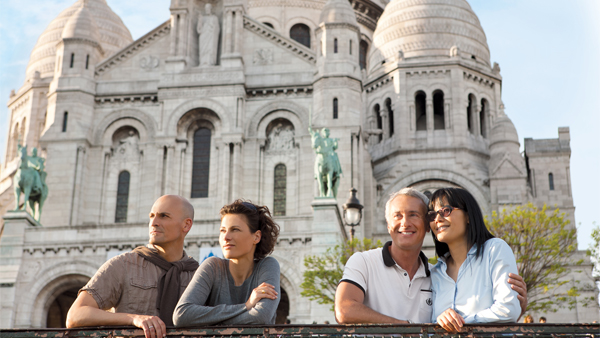
- Ship Name: S.S. Joie de Vivre
- Year Built: 2016
- Year Entered Present Fleet: 2017
- Ship Class: River "Super Ship"
- Maximum Capacity: 128
- Number of Passenger Decks: 3
- Number of Crew: 54
- Officers' Nationality: International
- Ocean-View without Balcony: 9
- Ocean-View with Balcony: 45
- Capacity Based on Double Occupancy: 108
- Country of Registry: The Netherlands
- Total Staterooms: 64
- Suites with Balcony: 10
- Crew/Hotel Staff Nationality: International
Costco Member Reviews

Available Dates & Prices
Terms & Conditions
*Price shown is per person based on double occupancy and is valid for select stateroom categories only. Click on the Terms & Conditions link below for details.
**Unlimited beverages include premium wine and premium spirits. Diamond List of wine and spirits is available at an additional cost.
♦♦Executive Members receive a $50 shipboard credit per person, maximum $100 per stateroom. Executive Member benefit is valid for primary cardholder only. Shipboard credit is per stateroom based on double occupancy. Shipboard credit will be applied to your onboard account. Any unused portion of the credit is nontransferable, nonrefundable and not redeemable for cash.
†One Digital Costco Shop Card per room/stateroom, per stay. The exact amount of the Digital Costco Shop Card will be calculated during the booking process. The Digital Costco Shop Card promotion is nontransferable and may not be combined with any other promotion. A Digital Costco Shop Card will arrive by email approximately 10 days after the start of your cruise. Click on the Terms & Conditions link below for additional information.
Ship's registry: The Netherlands
Image is an artist's rendering.












